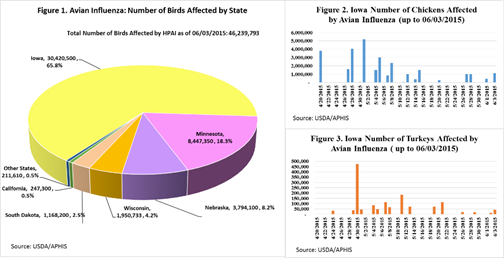Avian influenza (HPAI) continues to impact the poultry industry in the U.S., particularly in Iowa. Based on USDA's Animal and Plant Health Inspection Service (USDA/APHIS) data as of June 3, 2015, the total number of birds affected by HPAI was over 46 million birds. More than 65% (30.4 million birds) of the birds affected by the virus were in Iowa (see Figure 1). The number of birds lost due to HPAI in Iowa increased from 3.861 million on April 24, 2015 to 30.420 million by June 3, 2015. Ninety-five percent (28.973 million) of those birds were egg-laying-hens housed in commercial facilities and the rest (1.447 million) were turkeys, also housed in commercial facilities. As Figures 2 and 3 show, the number of birds affected by the virus in Iowa have been gradually decreasing since the beginning of the outbreak. Nevertheless, the latest (June 3, 2015) confirmed case involved 1.1 million layers. According to the USDA, warm dry weather, as well as plenty of sunshine (ultraviolet light) are among the climatological factors that reduce the life of the virus in the environment. Based on the latest (May 22, 2015) USDA/National Agricultural Statistic Service (NASS)'s Chicken and Eggs report, Iowa's inventory of layers on hand (59.5 million) in March 2015 represented about 16.4% of the total U.S. layer inventory (362.5 million) during that month. The report also indicated that Iowa's egg production was 1,413 million eggs in March 2015. Considering the number of layers (28.973 million layers) affected by HPAI so far, Iowa's egg production loss is about 688 million eggs (49% of March production).

A tighter egg supply due to the HPAI outbreak has contributed to higher egg prices. As Figure 4 show, egg prices have increased since the beginning of May 2015. Large egg weekly average prices (warehouse delivered) were $1.10/dozen across all regions of the U.S. and $1.01/dozen in the Midwest during the week ending on May 8, 2015. As of last Friday (June 5, 2015) the average price across all regions increased 120% to $2.43/dozen compared to the average price the previous month. At the same time, average prices in the Midwest rose to $2.41/ dozen, representing 138% increase from a month ago.

Current low feed costs and high egg prices can provide some incentive for producers to re-populate lost flocks. Once the process of cleaning, sterilizing, and inspecting poultry facilities affected by HPAI is over, the repopulation of lost flocks can begin. Since it takes about 18 weeks to have pullets ready to produce eggs and 15 to 25 weeks to have turkeys ready for the market, tighter Iowa supplies could last until next year.

